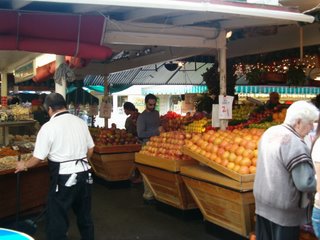
Today G and I took a small trip to the Los Angeles farmer's market. Located at Third and Farifax, it holds a piece of prime real estate and I was excited to see what a farmer's market in the heart of one of The United State's largest cities would be like. I've had a few experiences in with markets in the past, and even as a teenager I learned to love the market atmosphere.
My mother would coerse me with promises of freshly made cheese peirogies to get me from bed early on Saturday mornings. Together with my grandmother and her little pomerainian, we would drive out of the city to a small village called St. Jacobs.
A small community in the Waterloo region of Ontario, St Jacobs boasts of the largest Year-round farmer's market in Canada. However, ten years ago when my mother and I first began our weekend trips there, it was a small country market, with Mennonite farmers hawking produce and a few artisan vendors. It was not as 'lame' as I feared- I suppose I was just begining to nuture my life-long obsession with food.
Farmers we selling fruit from the beds of trucks and large folding church-basement bake-sale type tables. Women wearing bonnets prepared corned beef briskets, peirogies with sour cream and belgium waffles with real fresh maple syrup. They set the bar high in St. Jacobs, from that day on I expected low prices, excellent produce and a 'country' atmosphere from any farmer's market I encountered.
I was excited to see what was in store for us at the Los Angeles farmer's market.
I hoped for a 'country-comes-to-the-city' atmosphere, an oasis of real life inside this city of plastic surgery, entertainment and all it's falsehoods. "This market has been here ever since the Depression," I said to hubby as he drove us into West Hollywood. "It was developed to help the farmers generate income." My eyes were wide, taking in all new scenery as we drove through Inglewood and past many oil pumps. I was already thinking of what I would buy at the market: a basket of strawberries, maybe a couple steaks for dinner and some pastries if they looked REALLY good.
I knew farmer's markets inside big cities were different than St. Jacob's. Back in Toronto, in college, my friend Paul and I would plan lunch outings to the St. Lawrence market with a few of our classmates. It was a short walk to the pier on Wednesday afternoons to procure something a little more satisfying for a few budding chefs than the cafeteria had to offer. We would walk the full length around the oblong circle, watching fish mongers in rubber gloves filet fish and butchers wearing soiled aprons manhandle sides of beef. We argued over which butcher had the best looking steaks, and monitored prices between them all. There were often long lines at favorite lunch spots, such as the Italian deli downstairs where we often ate veal milanese or chicken parmesean sandwiches. Another favorite was churasso chicken, on a soft white bun with extra sauce and mayo. The line would stretch across the walkway: full of students, professionals looking impatient, and sometimes, local chefs carrying parcels meant for their restaurants. After lunch, we would hit the produce vendors, who had their products piled in boxes with small handwritten signs proclaiming their cost. Which ever vendor had the best fruit at the lowest price usually won our buisness, and we would often buy a box of strawberries or a bag of cherries to munch on during the walk back to school. 'Wouldn't it be great to buy all your groceries here?', someone was likely to comment. A lofty goal, and one on which we all could agree.
I couldn't wait to see how the LA market measured up to my rose-coloured view of Wednesday afternoons at St. Lawrence, and the fading memory of Mennonite fruit. As G and I approached the building, I immeadiatly noticed how well-kept and clean everything was. The first shop I noticed was selling waffles and panckes with strawberry sauce and I immeadiatly regretted the bowl of oatmeal I ate for breakfast. Around the corner, and we found a butcher, a wonderful-smelling bakery and a produce vendor. I stopped in shock at the 'Whole Foods'-quality of the displays of produce.

I was expecting to find ripe and beautiful products, but the set-up was perfect and not at all what I have come to anticipate from farmer's markets. It actually turned me off buying anything, since it was so much like a grocery store. I only counted two produce vendors, two butchers, and one fish monger. And I didn't see a single person in a dirty apron. The market was fitting for Los Angeles- everything is dressed up and super-clean. The prices were NOT cheaper than the grocery store. In fact, I didn't notice many people buying groceries at all- it seemed like everyone was there just to wander around and bask in the glow of BEING AT a farmer's market rather than embracing it, and actaully purchasing stuff.

The farmer's market at the Grove is a perfect example of how commercialism can engulf and consume anything in it's path. The purpose of farmer's markets is to give the farmers a chance to interact with both the consumers and their competition,, and cut out the middleman to offer their products at a reduced cost. It is supposed to create community between the consumers and the producers and also friendly competition between vendors. At the Los Angeles farmer's market, I found no community or competition. What I did find was a tourist destination with inflated prices and the bland facade of just another grocery store.
I always
Here's what they should do: by giving spcae to many farmers, at a low rent, it will encourage both low prices and people to buy their groceries there. Other than lower price, freshness, and supporting the farmers directly, what is the point of having it at all? As a tourist destination? Maybe it is. It was just SO commercial.
farmer's market
los angeles
food

No comments:
Post a Comment